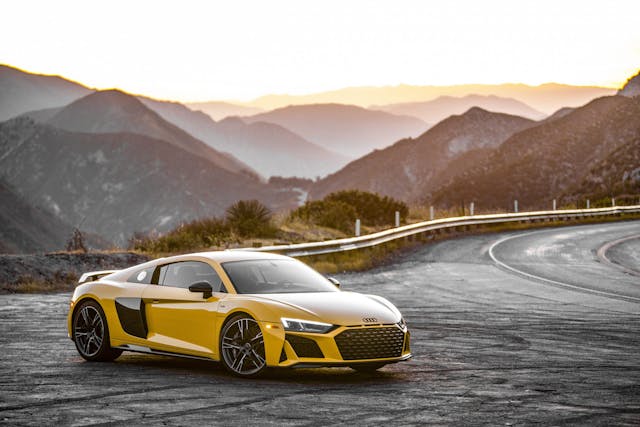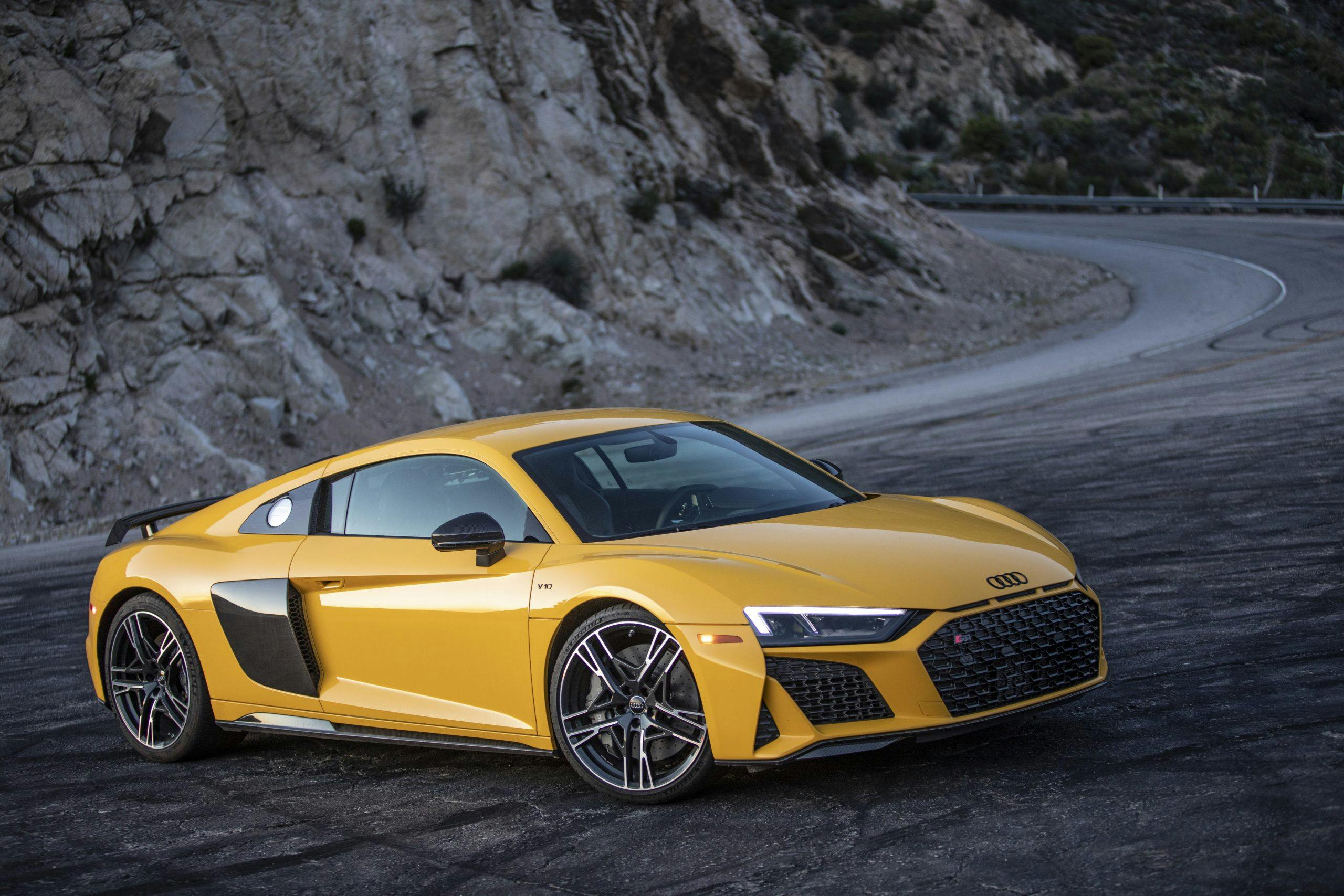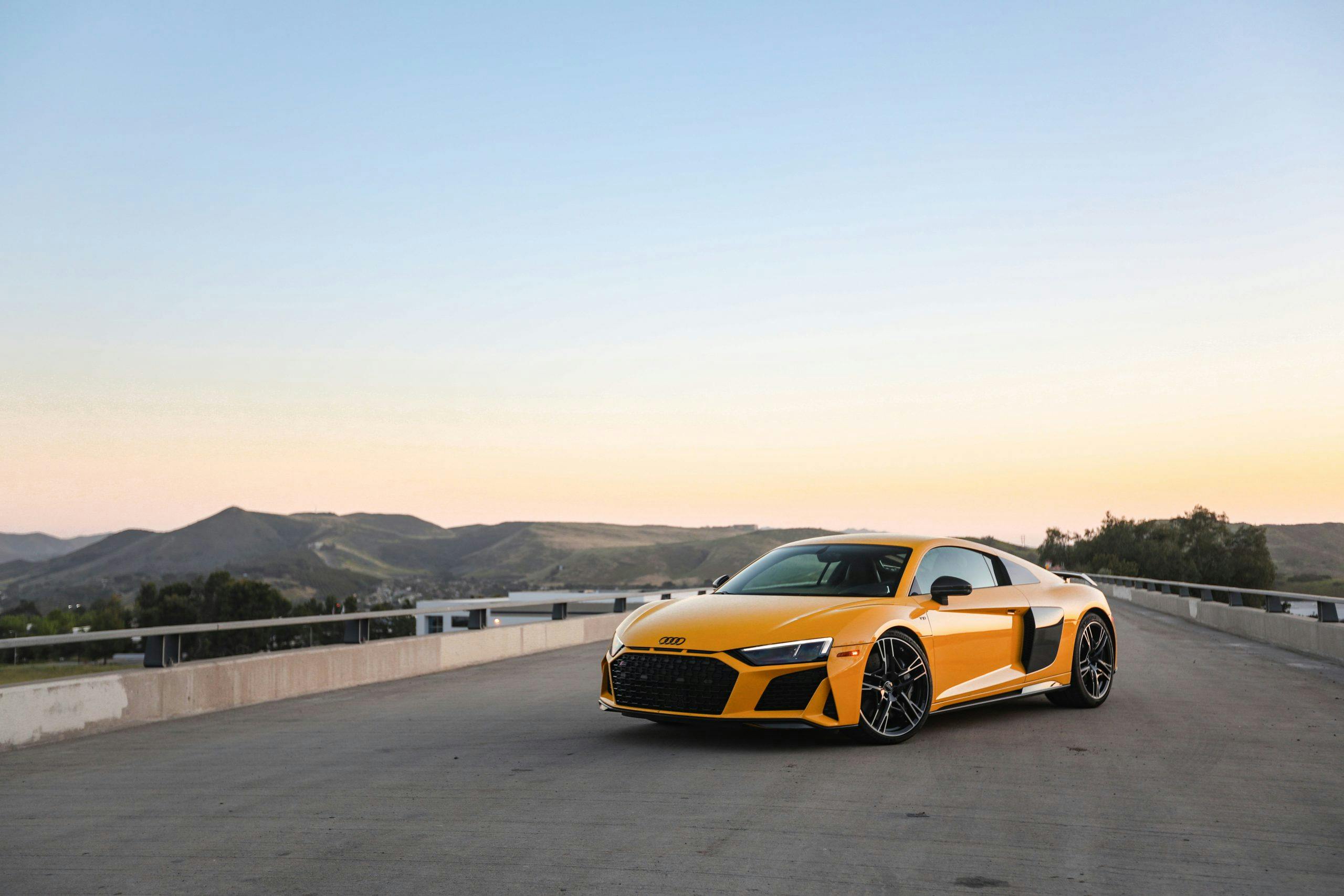Review: 2020 Audi R8 Performance
Just as the 2020 zombie apocalypse was hitting its peak, Audi offered up a new R8 for us to play with for a few weeks. Perhaps the automaker felt more comfortable handing us the key to its $215,150 wondercar knowing full well that there wasn’t any place to go in it. A long road trip was out as hotels were closed and townsfolk were looking askance at anyone with out-of-state plates. We would have to pack a picnic for any lengthy day trip because restaurants were mostly shut up tight. In fact, the best place to drive a 602-hp super coupe at that moment was through downtown Los Angeles, which was as empty as ancient Carthage after the Romans worked out their anger management issues on it.
Turning down such an invitation would be proof of insanity in any courtroom, however, so this chortling mid-engine ingot of the German sportliches leben was delivered by a guy wearing gloves and a mask, always making sure to stand six feet away while explaining the delights of the $5000 Sport Seat Package with diamond stitching and 18-way power controls. Who said social distancing can’t be fun?

You have to go all the way back to the year 1999 to remember why the Audi R8 even exists. Back then, Volkswagen’s luxury brand was busy overhauling its image with a mega-dollar endurance-racing program that would blitzkrieg the great tracks of the world. Le Mans, Sebring, Spa, Jarama, Road Atlanta; they all fell to the Audi R8R and its successors, the silver and red sports-prototypes winning the famed French 24-hour enduro no less than five times in six years starting in 2000 (the Bentley Speed 8, which was based on the Audi R8 and used a version of the Audi R8’s engine in a car bearing a marque that is a subsidiary of Audi, “broke” Audi’s winning streak in 2003).
The slinky R8 road car with its Quattro all-wheel-drive and trademark side fin of either aluminum or carbon-fiber came into being in 2008. The racing linkage was obvious to everyone. The R8 LMP ran a direct-injected gasoline V-8, so did the road car. The racer had paddle shifters; so did the road car. That is, if you defied logic and optioned the automatic over the six-speed manual that was available in those early cars. Built around an evolution of the aluminum spaceframe inside the Lamborghini Gallardo, the new R8 was sophisticated, sublime, comfortable for everyday use, and at the time, utterly state of the art. Both car mags and buyers swooned.
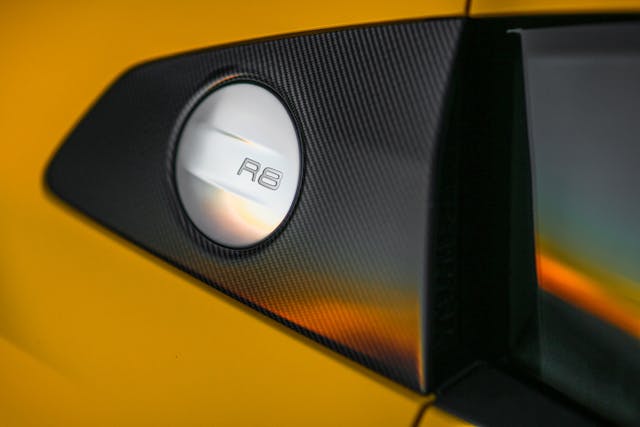
Fast-forward 12 years. After several makeovers and modifications, and after Audi got bored with winning Le Mans and with paying the hideous costs (money now largely siphoned off to the VW Group’s huge electrification effort), the R8 road car is still somehow with us. It’s like the old supercar that lives in the crumbling mansion out on Sunset Boulevard, an almost forgotten relic of an earlier golden age that will eagerly stand in front of any spotlight turned on it. About a thousand people worldwide still buy an R8 every year, including both the coupe and the convertible, meaning they sell roughly 37 new Porsche 911s for every R8. They are still riveted and welded up mostly by hand—but with some strategic use of a few underutilized robots—in one small hall at Audi’s sprawling Neckarsulm assembly complex between Stuttgart and Frankfurt. They even race; Audi supports several teams fielding R8 LMS race cars in competition.

Thus, though it wears the four-ring badge (which in black costs 300 bucks extra) of a familiar entry level luxury brand, the R8 is pretty exotic. Indeed, it still shares a lot of its componentry with the current Lamborghini Huracán, down to the naturally breathing 5.2-liter direct-injection V-10 engine, the last survivor from a long-ago fad for V-10s whose adherents once included the BMW M5, the Dodge Viper, the Lexus LFA, every car on the F1 grid in the early 2000s, and the Ford Econoline. When the Audi V-10 goes away, which will likely be in the next couple of years, the replacement will almost certainly be a hybrid powertrain of considerably smaller turbocharged displacement. So, this is a probably a last fling of sorts. Turbos and electrics are already rampant in the Alcantara-ashtray class, with Ferrari and McLaren embracing them wholeheartedly, so this free-breather with its 8700-rpm redline is a reminder of the way things used to be.
Audi wanted the R8 from the outset to be daily useable; it’s even engineered to hold a bag of golf clubs behind the seats. So we put it into daily use. That is, within the scope of quarantine orders, as nobody was commuting and simple runs for groceries were like reenacting certain chapters of Cormac McCarthy’s The Road.
Though the R8 model has been around awhile, the opulent, leather-laminated cockpit has been thoroughly updated with Audi’s latest suite of Multi-Media Interface (MMI) screens. Representing some designer’s idea of what an Audi X-Wing Fighter would look like inside, the motif is one of organic black forms enveloping the driver as a cybertronic wetsuit might hug a scuba-droid. The instrument cluster is entirely digital, just a flat screen with high-res graphics. Where there used to be simple tachometers and volt meters in sports cars, a lovingly precise pictogram of an R8 pops up and spins around in 3-D when you need to fiddle with one of the car’s adjustments. With a steering wheel button, you can reconfigure the gauges depending on your situation and desire to know rpm or present mph. It can also display a supersized version of the nav map so it forms one giant multicolor tapestry on your dash.

The wide, flat seats seem welcoming at first but they are stiff, as befits the car’s mission to squash organs against rib cages at every opportunity. Part of that $5000 fancy-pants package includes a diamond-pleated headliner. We had the car a couple weeks and thought that its 104.3-inch wheelbase (factoid: that is identical to that of a Porsche 956 racer) seemed abundant to providing ample legroom for taller drivers. Then, part way through our time with the car, we met a cashed-up real estate guy of six-feet-even who said he had to take his new R8 Spyder back after a few weeks because he was so uncomfortable in it. Your 5-foot, 11-inch author, who had been feeling perfectly sized for the car, immediately went out and tried to move the seat back, only to realize that there was maybe an eighth-of-an-inch left in the track for travel. Taller drivers should definitely try one on before buying.
Ignite the V-10 with the red start button and all ears in the neighborhood turn your way. The exhaust actually has loud and quiet modes, but the emissions requirement to rapidly torch the catalysts means a cold R8 wakes up like a dozing lion that you’ve just poked with a pitchfork. After about 20 seconds the frenetic bawl settles down as the flaps in the mufflers snap closed. Another prominent button on the steering wheel, labeled with the image of two square exhaust pipes (which look nothing like the R8’s large, round pipes), lets the driver lock the exhaust into its sport mode, which keeps the flaps cranked for continued rasping and barking during your journey.

As befitting its daily-driver mission, the R8 has progressive controls that let you waft it along at normal traffic speeds without any driveline bucking or unexpected brake-dives. Audi gives you three aggression settings: Comfort, Dynamic, and Individual, the latter letting you individually adjust drive elements like the steering heft and transmission shift maps while leaving other elements, such as the stability control threshold and exhaust note, alone. That’s great, but our only complaint is that the automatic dual-clutch transmission needs a couple more settings. As it is, the car only gives you the option in the shifting department between “snore” and “kill.”
In Comfort (snore) mode, the seven-speed “S-Tronic” transmission rapidly jumps to its highest gear—it’s not actually that high, with the short-ratio box producing around 3000 rpm at 75 mph—and only downshifts if you push deep into the throttle. At that point, it drops three or four gears and the engine erupts with a howl of revs. It happens at sometimes embarrassing moments, like when you just want to speed up a bit to catch a soon-to-be-changing light, or maybe slip right into a hole in the other lane. In snore mode, you can’t have medium acceleration without upending a 55-gallon drum of supercar rage on the street. Cops love when you do that.
You go into Individual and set the transmission to its Dynamic (kill) mode. Now, every time you simply touch the brakes—for a light, for a freeway exit, for that line of cars that always stretches into the street from the Popeye’s drive-through—the transmission acts like you’re braking for the first chicane on the Mulsanne. It bangs in downshifts one at a time with whooping throttle blips, all of which causes your head to pigeon back and forth as you try to keep your blurred vision focused on the thing you were braking for in the first place. The only solution is to always shift the transmission manually. Which would be a lot more pleasing if it was an actual manual transmission rather than an arcade-game facsimile of one with paddles.

Otherwise, we couldn’t discern much difference between the R8’s Comfort and Dynamic modes. Overall, the suspension is on the firm side, the ride a little crashing over misaligned seams in the freeway. The base R8, which starts at $171,150 as a coupe and has “only” 562 horsepower, comes equipped with computer-adjustable shocks. The more deluxe Performance model like our Vegas Yellow (really, that’s what it’s called) example has what Audi labels a “fixed sport suspension,” meaning it is firm and will always be that way. (That particular paint color is an Apis mellifera magnet of the first order, and the bees apparently took out their frustration at the car not being a flower by pinching loaves all over it in little orange dots. We would never do that.)
Perhaps just our particular unit was not properly aligned, but the car also seemed to wander a bit on the freeway, having less of a sense of straight-ahead than most laser-focused sportsters. Dynamic steering, which for $500 extra gives the rack a variable ratio, is probably at work here, making the helm easy when it needs to be and sportier when you’re going for it in curves.
We escaped Los Angeles to the hills a few times to let the R8 run off the leash. The power is stupefying, and the acceleration smears the scenery when fully uncorked. It’ll hit 60 mph in a little over three seconds, according to the factory. The engine isn’t obscenely loud, even with the loud button switched on, but it does make itself heard with that meaty V-10 burr that is so distinct from the yapping screams of a Ferrari or the steel-cut wail of a Porsche. Twin flaring exhaust tips that look like city water mains are part of a mild refresh of the car’s exterior for 2020 that increases the amount of crease at the corners and the grille area both front and rear.
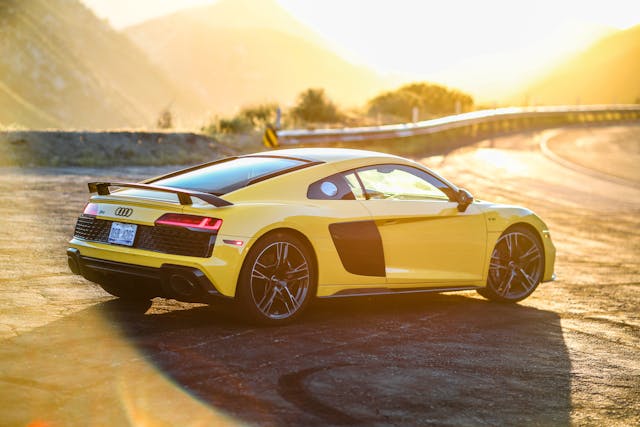
You can eat miles quickly in this machine and with the confidence of huge grip and all-wheel-drive security, but you can have more fun in some other cars, from a basic Miata to a Porsche 911 Turbo. The current iteration of the R8 is just a bit too emotionless, more function than form than that glorious first-generation R8. The return of the rear-drive R8 that the U.S. is supposed to receive could alter the fun equation somewhat, but so far that’s just a rumor. Perhaps the issue is not the Quattro system but with all the changes at VW since the R8 first came out, including the absorption of Porsche into the group its subsequent position of developer of all of the group’s sports cars, including the R8. It’s possible that Zuffenhausen doesn’t want Ingolstadt to have a better car than its Porsche 911, a situation that was definitely the case in 2008.
Let’s face it, though, if you’re going to drop the engine behind the seats, you might as well go all-in with the emotion. Otherwise there’s just no point to the exercise. Honda surely learned that with the supremely subdued Acura NSX, which does more amazing things more quietly than any car ever made. Indeed, the NSX is the closest analogue to the R8 both in price and temperament, and if the R8 survives into another electrified generation, it will resemble Acura’s supremely hushed and polite supercar even more. It’s not clear that this market is anything but sliver of a sub-niche, so don’t bet the farm on it happening, but it’s possible.
We washed the accumulated bee poop from the R8, shot some photos, and returned it to its maker. The R8 is glorious, and when it’s gone, so will be the era of the free-breathing, big-engine exotic. And the world will be a less wild place for it.
